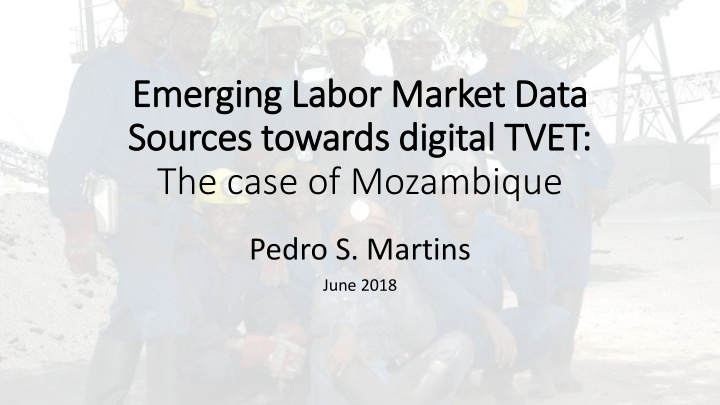



Emerging La Labor Market Data Sou ources t towards digital TVET ET: The case of Mozambique Pedro S. Martins June 2018
Mozambique - Overview • GDP per capita of USD 700 but significant growth since late 1990s • Rich natural resources, incl natural gas, coal, iron and copper • 28 million inhabitants (incl 5m aged 15-25) • Fewer than 3m with secondary schooling or above • Unemployment of 20.7% (2015): higher in urban areas, for the young, women and better educated • Labour market information system: Observatory, PES, training agency, online portals, etc 2
Labour M r Market Observatory • Public agency with the Ministry for Work, Labour and Social Security (MITESS), launched in 2016 • Goal: to increase information about labour market issues, so to improve the capacity of the Government and other stakeholders on the ‘design and implementation of the employment policy’, based on the ‘analysis of accurate data on employment, training and socio-economic trends’ • Supported by 2015 grant from African Development Bank (USD 740k) to establish the labour market information system • Currently five staff; ILO recent proposal of significant further investment • Main partner is the Statistical Agency. Other partners include: • Ministries of Public Administration; of Education; of Science, Technology, Higher and Vocational; of Industry and Trade; • Province directorates of Labour and Social Security; • the Foreign Investment Promotion Agency; the National Institute of Social Security; the Confederation of Economic Associations; the Commission for Labour Mediation and Arbitration; and the National Directorate on Migrant Labour 3
Labour M r Market Observatory • Publication of quarterly and annual reports, based on processing and compiling labour data from multiple agencies • Registered formal jobs, by types, provinces and industries • 4th quarter of 2017: Stock: 460k; Flow: 81k • Active labour market policies and training • Immigration and emigration • Approved investment projects and expected jobs • Analysis of vacancy data, from online portals and newpapers 4
Public Employment Services • Instituto Nacional de Emprego (INEP, National Institute for Employment), created in 2016, from the former INEFP • Goal: deliver (free) services of labour market matching, career information and guidance, traineeships, and labour market information • 25 jobcentres across the country, with a total of 128 officials • 4 th quarter: 2,105 vacancies, 2,063 placements and 179,018 registered unemployed jobseekers • Online portal launched in May: 14 vacancies and 2,350 jobseeker registrations • Private sector: 23 registered private employment agencies 5
Training Agency • Instituto de Formação Profissional e Estudos Laborais Alberto Cassimo (IFPELAC), created in 2016, from the former INEFP • 42,804 individuals attended vocational training, 62.7% of which in private training centres (4 th quarter of 2017) • Several ongoing partnership with multinationals (eg mining sector) • Example: recent MoU with an Australian mining company, including construction of training centre and support over 100 trainees per year over at least five years • ‘Integrated reform programme of TVET’ (PIREP) • Four components: Development of an Institutional Framework, Standards-based Qualifications and Training System, Quality Improvements in TVET Institutions, and a Skills Development Fund • 2015: 140 technical education schools (67 public) and 67k students (43k public) 6
Additional public/survey data sources • Household budget survey, conducted in 2014/15, 2008/09, 2002/03 and 1996/97 by the Statistical Agency, incl Employment section • Last LFS in 2005, new one planned for 2019 • Census conducted in 2017, incl employment status • Individual formal employees per firm: ‘Folha de Relação Nominal (FRN)’ (matched employer-employee panel data) • Social security: ‘Sistema de Informação da Segurança Social de Moçambique (SISSMO)’ • Migrant workers: ‘Sistema de Gestão do Fenómeno Migratório (SIMIGRA)’ • 2017 survey of over 500 manufacturing sector firms conducted by universities (Eduardo Mondlane, Copenhagen, UN-WIDER) • Ongoing survey of graduates 7
‘Folha de Relação Nominal (FRN)’ (matched data) variables (examples) 8
Online Portals – The Case of UX emprego.co.mz online jobs portal: • Online registration and matching of formal labour market vacancies and (employed or unemployed) jobseekers • 2014-2018: 127,833 jobseekers, 12,837 vacancies and 1,608 firms • Detailed background info & microdata on labour demand and supply biscate.co.mz online gigs portal: • GSM USSD technology (basic mobile phone network) • Large number of pre-defined occupations (gardening, plumbing, etc) • 2016-2018: 59,355 self-employed individuals and 40,118 users Skills for Oil ad Gas (SOGA) collaboration 9
Applicants’ schooling and vacancies’ schooling (analysis of emprego.co.mz micro data ) 10
Conclusions • Despite gaps in resources, labour market information system is now established, with important contribution from Labour Market Observatory • A number of challenges and opportunities remain: • Information from (huge) informal sector incomplete • Monitoring and (impact) evaluation of training activities still in early stage of development • Novel sources of data, including from the private sector, offer great potential • Opportunities for partnerships with international organisations 11
Recommend
More recommend